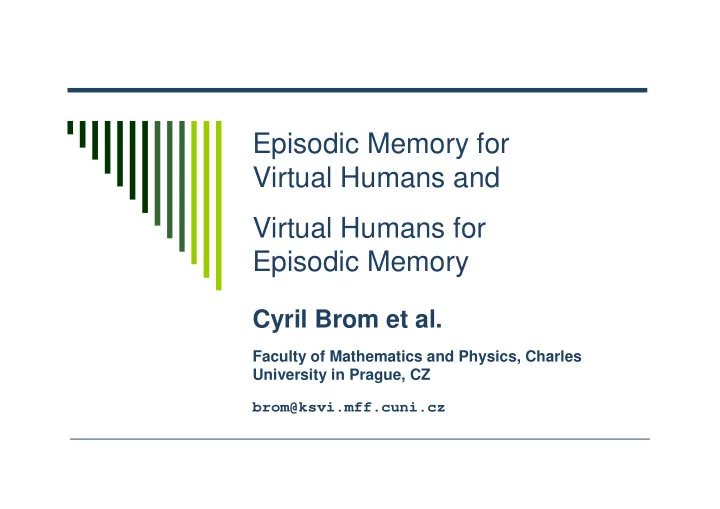

Episodic Memory for Virtual Humans and Virtual Humans for Episodic Memory Cyril Brom et al. Faculty of Mathematics and Physics, Charles University in Prague, CZ brom@ksvi.mff.cuni.cz
Team � Jakub Gemrot, Michal Bída, Ond ř ej Burkert, Klára Pešková, Tomáš Korenko, Jan Vyhnánek, Rudolf Kadlec, Jakub Kotrla, Lucie Ku č erová, Lukáš Zem č ák � Funding agencies: IS, MSMT
Virtual humans for episodic memory
Neuro/psychological perspective � Memory for personally personally � Place cells, grid cells, experienced past events head - d irection cells... (episodes) � Morris water pool, ... � Recall of an event in the spatio-temporal context in which it was experienced � H.M. � Tulving (1983) � Baddley (2000, 2001) � Forensic psychology
Types of research � Animal research � spatial cognition � episodic-like memory � Casuistries � “Laboratory” cognitive psychology � world-list memorising etc. � Forensic psychology � Computational modelling � robotic artifacts
State of the art � A couple of computational models � fundamental research vs. engineering � These models: � tend to focus only on a narrow range of phenomena, � most importantly: space vs. events � exceptions are rare � typically oriented on short-term intervals, � do not support representation of do not support representation of � complex plausible human - like episodes . complex plausible human - like episodes
Main methodological proposal � This state of affairs can be improved using the technology of virtual virtual environments inhabited by intelligent intelligent environments virtual agents as a test test- -bed bed for virtual agents developing, investigating, and integrating various neuro-/psychologically plausible models of episodic and/or spatial memory.
Complex episodes � Interaction with multiple objects � e.g. cooking � Large spaces � e.g. a city � Long periods of time � e.g. months, years
Main advantages of virtual worlds � Features: � more technically accessible and cheaper then robots � low-level (e.g. distances, pixels) vs. high-level (e.g. affordances) � ecologically plausible models of real worlds (to some extent) � speed-up time � Robots or virtual agents? � trade-off: crippled worlds with “natural” noise vs. large worlds � the “robotic risk” : you see the phenomena through the hardware limitations � the “virtual agents risk”: you see the phenomena without any limitations � Main Pros: � integration of “single-phenomena” models � combination of levels of abstraction � large environments � longitudinal studies in virtual reality settings with human subjects
Pogamut
Integrated Development Environment
Integrated Development Environment Development Debugging Support for experimenting - parallel computing Education
Episodic memory for virtual humans
Our episodic memory research � Purpose: Hybrid � agents for serious games � neuro-/psychologically plausible � methodological: a vehicle for other models � Main focus � complex episodes � large spaces � long periods of time � integration of perception of space and events
Our episodic memory research � Main issues � Representations of complex episodes, large spaces, life-time intervals � Plausible forgetting � blending of episodes, false memories � perception of time, time as a cue � Context abstraction � Techniques � symbolic � connectionist
Our agent architecture ENV STM Goals Structure objects tasks Task select ion Attention Filter PF <invoke TF a subgoal> DRIVES MF Conflict resolution <search> <remember mechanism location of an object> <remember <recall> episode> ACTION Emotions <influence> LTSM LTEM ENV Lingv. module VERBAL OUTCOME
Example – – Example a virtual shaman a virtual shaman � Autobiographic memory with forgetting � 5 - d ays � Dynamic scenario � Debriefing “I was doing SearchRandom for smokeability because of Smoke. I was doing go from room 1 to room 2 because of SearchRandom. I was doing look in environment because of SearchRandom. I was doing go from room 2 to room 5 because of SearchRandom. I was doing pick up Calumet1 because of Smoke. I was doing Smoke.”
Forgetting – example (no “emotions”)
Forgetting – example (with “emotions”)
Positions of objects in large worlds � Searching strategies: � where are the glasses? � Could be at your bedside table. concrete � If not, could be next to the TV. � If not, scrutinise your study room. abstract � If not, scrutinise the whole flat.
End We have a poster! We have a poster!
Recommend
More recommend